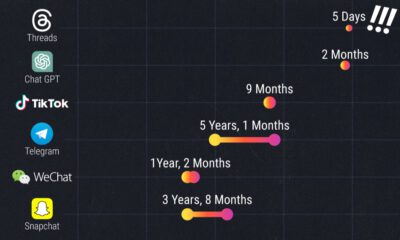Misc
What Can We Learn From the Desks of Elon Musk and Mark Zuckerberg?
How a person leaves their office desk can tell you a lot about them.
Is it organized chaos, bursting with new plans and ideas to take the world by storm? Do sentimental photos of family and moments adorn the area surrounding the workspace? Is the desk organized, meticulously cleaned, and orderly?
The structure of a person’s work environment, along with the routines they use for enhancing productivity while at the office, can help give us insight on how they work best – and this becomes especially interesting when we look at the strategies and tactics used by some of the world’s most extraordinary people.
Famous Desks and What We Can Learn
Today’s infographic comes from the Pens.com, and it highlights the work habits, routines, and desks from extraordinary people like Albert Einstein, Ernest Hemingway, Arianna Huffington, Elon Musk, and Mark Zuckerberg.
Let’s see what we can take away from these examples:

Each approach above is unique – and each set of tactics helps that extraordinary person in getting closer to reaching their objective.
Lessons from the Greats
Here are some of our favorite lessons that we thought were the most tangible:
Mark Zuckerberg
Consistent with his grey t-shirt and jeans approach to his wardrobe, Zucks also keeps his workspace simple. He doesn’t have an office, and instead works with the same desk setup as every other Facebook employee.
Lesson: As a leader, the way you dress and set up your work environment also communicates your values to the organization and the outside world. Mark Zuckerberg keeps his environment simple to help him focus on the bigger problems, and this vision shines through crystal clear to inspire the people around him.
Elon Musk
At the Tesla office, Elon Musk set his desk up at the end of the Model X assembly line so he could personally inspect each finished vehicle.
Lesson: When doing something bold and visionary, there must be constant attention to detail to ensure that the end product meshes with the vision. Elon could have put his desk somewhere with a nice view, or in a corner office. Instead, by setting up his desk in this strategic position, it gave him assurance that the vehicles coming off the line were going to meet his uncompromising quality standards.
Albert Einstein
Einstein believed that cluttered desks were the sign of a cluttered brain, with lots of things going on. As such, he wondered what was going on in the brains of people with perfectly tidy workspaces!
Einstein also thought that combining unrelated concepts to generate new, creative ideas was a secret of genius.
Lesson: Studies have shown that messy desks are linked to creativity – something that Einstein needed when solving “outside the box” physics problems like relativity.
Arianna Huffington
For anyone that has read her book, Sleep Revolution, it’s clear Arianna Huffington believes that people are generally quite sleep-deprived. For these reasons, she encourages naps to boost productivity in the workplace.
Lesson: Arianna Huffington has “owned” the discussion around sleep, and how proper habits can help with work productivity. It’s no surprise she walks the talk, as well.
Ernest Hemingway
Hemingway thought he did his best work standing up, and he also kept a tally of his daily word count in front of him.
Lesson: While studies show working while standing up can enhance productivity by 10% – more importantly, Hemingway did what works best for him, even though it was unconventional. He also knew that monitoring his most important KPI, and keeping that metric right in front of him, would allow him to best gauge his progress on achieving his vision.
VC+
VC+: Get Our Key Takeaways From the IMF’s World Economic Outlook
A sneak preview of the exclusive VC+ Special Dispatch—your shortcut to understanding IMF’s World Economic Outlook report.

Have you read IMF’s latest World Economic Outlook yet? At a daunting 202 pages, we don’t blame you if it’s still on your to-do list.
But don’t worry, you don’t need to read the whole April release, because we’ve already done the hard work for you.
To save you time and effort, the Visual Capitalist team has compiled a visual analysis of everything you need to know from the report—and our VC+ Special Dispatch is available exclusively to VC+ members. All you need to do is log into the VC+ Archive.
If you’re not already subscribed to VC+, make sure you sign up now to access the full analysis of the IMF report, and more (we release similar deep dives every week).
For now, here’s what VC+ members get to see.
Your Shortcut to Understanding IMF’s World Economic Outlook
With long and short-term growth prospects declining for many countries around the world, this Special Dispatch offers a visual analysis of the key figures and takeaways from the IMF’s report including:
- The global decline in economic growth forecasts
- Real GDP growth and inflation forecasts for major nations in 2024
- When interest rate cuts will happen and interest rate forecasts
- How debt-to-GDP ratios have changed since 2000
- And much more!
Get the Full Breakdown in the Next VC+ Special Dispatch
VC+ members can access the full Special Dispatch by logging into the VC+ Archive, where you can also check out previous releases.
Make sure you join VC+ now to see exclusive charts and the full analysis of key takeaways from IMF’s World Economic Outlook.
Don’t miss out. Become a VC+ member today.
What You Get When You Become a VC+ Member
VC+ is Visual Capitalist’s premium subscription. As a member, you’ll get the following:
- Special Dispatches: Deep dive visual briefings on crucial reports and global trends
- Markets This Month: A snappy summary of the state of the markets and what to look out for
- The Trendline: Weekly curation of the best visualizations from across the globe
- Global Forecast Series: Our flagship annual report that covers everything you need to know related to the economy, markets, geopolitics, and the latest tech trends
- VC+ Archive: Hundreds of previously released VC+ briefings and reports that you’ve been missing out on, all in one dedicated hub
You can get all of the above, and more, by joining VC+ today.
-

 Debt1 week ago
Debt1 week agoHow Debt-to-GDP Ratios Have Changed Since 2000
-

 Markets2 weeks ago
Markets2 weeks agoRanked: The World’s Top Flight Routes, by Revenue
-

 Countries2 weeks ago
Countries2 weeks agoPopulation Projections: The World’s 6 Largest Countries in 2075
-

 Markets2 weeks ago
Markets2 weeks agoThe Top 10 States by Real GDP Growth in 2023
-

 Demographics2 weeks ago
Demographics2 weeks agoThe Smallest Gender Wage Gaps in OECD Countries
-

 United States2 weeks ago
United States2 weeks agoWhere U.S. Inflation Hit the Hardest in March 2024
-

 Green2 weeks ago
Green2 weeks agoTop Countries By Forest Growth Since 2001
-

 United States2 weeks ago
United States2 weeks agoRanked: The Largest U.S. Corporations by Number of Employees















